
| ||||||||||
|
||||||||||
Lion Notes 2Welcome to page 2 of images and brief notes about lions, lion sightings and lion behaviour based on visits and photo safaris to game reserves and national parks in southern and East Africa. All images © Scotch Macaskill - for more, see Terms of Use.Young Male Lion with Leaf in Mane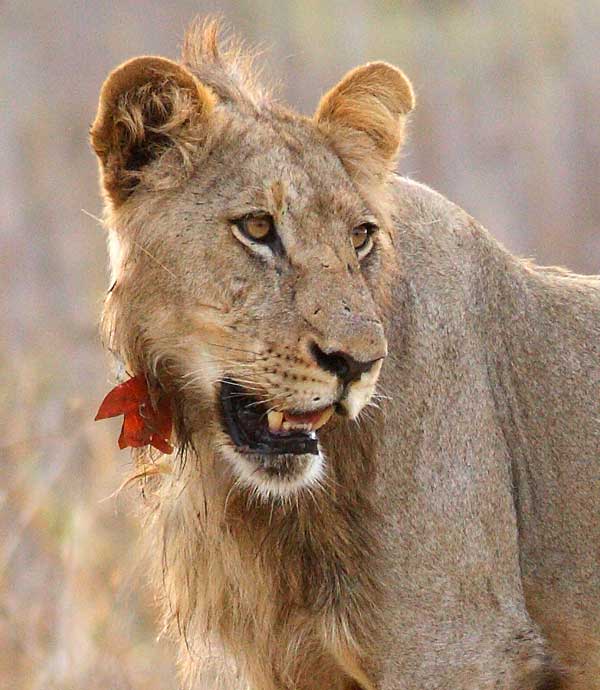 Photo Details: Young male lion with winter leaf stuck to his mane, Kruger National Park, South Africa.
Photo Details: Young male lion with winter leaf stuck to his mane, Kruger National Park, South Africa.
Camera: Canon EOS 450D (Canon Rebel XSi 12.2MP); Canon EF 400mm f/5.6 L USM; Focal Length: 400mm; Shutter speed: 1/1000; Aperture: f/5.6; ISO: 800. This immature male was part of a larger group of young lions, including both males and females, that we found near Engelhard Dam while staying at Letaba Camp in the Kruger National Park. There were no mature adults in the group but from the age of the lions (probably around 2 – 2½ yrs) it’s probable they were still members of a larger pride. Young males are usually evicted from the pride by the dominant male (or males) at around 2½ – 3 yrs old. Females on the other hand tend to stay with the pride on maturing, although they may occasionally disperse with their evicted brothers. The social life of lions is complex and there are no hard and fast rules. Prides may fragment, depending on numbers and size of territory, and then continue to live in adjacent or overlapping ranges. Young males, after eviction from the pride, will become nomads, with brothers often staying together, forming coalitions. This enhances their chance of survival during this dangerous period when they have to cross territories occupied by larger and stronger resident males. When the youngsters are old enough, they will attempt to take over a pride by challenging the resident male(s), at which stage a coalition offers a distinct advantage. See Lion Facts for more about the social structure of these big cats. Lion Male Blends with the Bush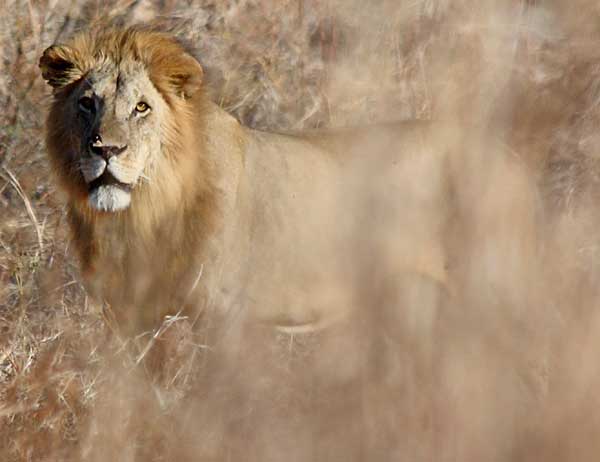 Photo Details: Adult male lion blends in with the golden hues of surrounding winter vegetation in Ruaha National Park, Tanzania.
Photo Details: Adult male lion blends in with the golden hues of surrounding winter vegetation in Ruaha National Park, Tanzania.
Camera: Canon EOS 450D (Rebel XSi); Lens: Canon EF 70-300mm f/4.5-5.6 IS USM Telephoto Zoom; Focal Length: 300mm; Aperture: F/6.3; Shutter Speed: 1/1600; ISO: 400 We spotted this big male lion on the side of the road, soon after we’d left our camp on the banks of the Great Ruaha River in Tanzania’s spectacular Ruaha National Park on a morning game drive. Not long after this, two of our travel companions, who left shortly after us, saw the big fellow wandering close to our tents. Fortunately no one was sleeping-in, but it was a timely reminder of how vulnerable one is when camping in the African bush. See our article, Lion Visits our Camp in Ruaha for more. Lioness Lying Upside Down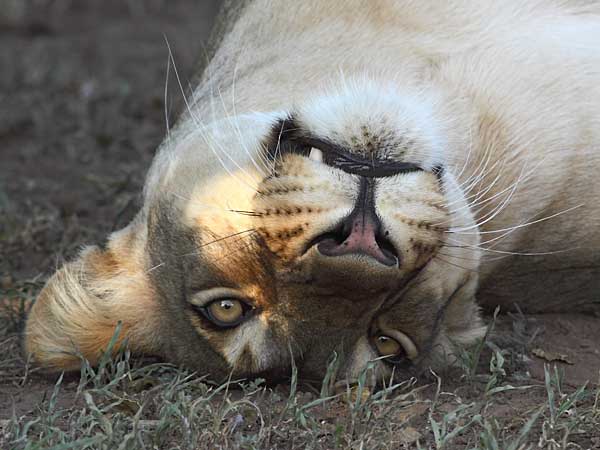 Photo Details: Lioness, while lying on her back with head on the grass, keeps an eye on us from this unusual position, Mashatu Game Reserve, Botswana.
Photo Details: Lioness, while lying on her back with head on the grass, keeps an eye on us from this unusual position, Mashatu Game Reserve, Botswana.
Camera: Canon EOS 50D; Lens: Canon EF 400mm f/5.6L; Focal length: 400mm; Shutter speed: 1/640; Aperture: f/8; ISO 800 We were watching two lionesses, more than likely sisters, affectionately nuzzling and licking each other (below), when the one rolled on her back briefly, all the while keeping her gaze on us. I find the image quite intriguing because of the direct eye contact from an unexpected angle. Lions are regarded as the only truly sociable cats, with social licking and head rubbing being common among members of a lion pride. It is assumed this behavior plays a part in reinforcing social bonds, as does the greeting ceremony performed by lions. According to Richard Despart Estes (The Behavior Guide to African Mammals), “pride members have to go through the greeting ceremony whenever they meet, as a proof of membership in the pride and of peaceful intentions”. 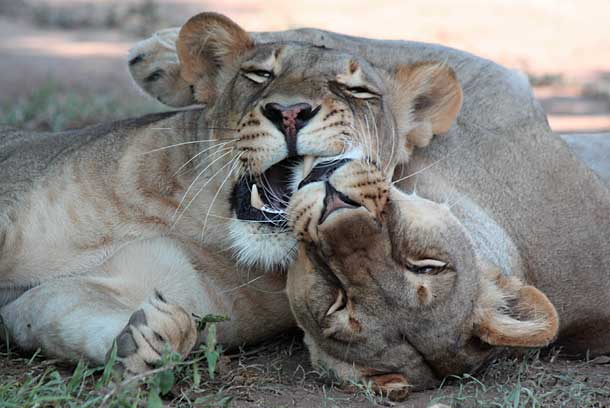
The Lion’s Tongue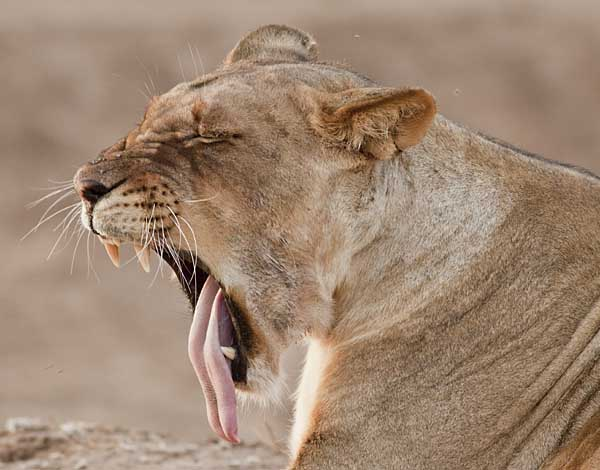
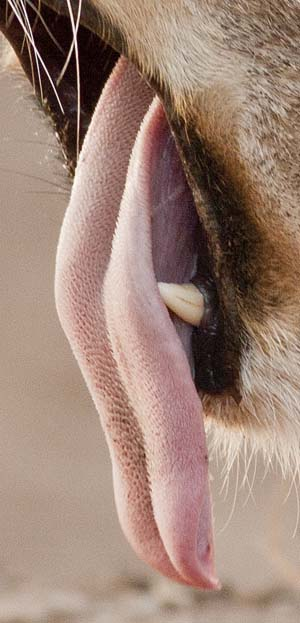 Photo Details: Yawning lioness (above and right) showing the long tongue with papillae or barbs on the surface.
Photo Details: Yawning lioness (above and right) showing the long tongue with papillae or barbs on the surface.
Camera: Canon EOS 50D; Lens: Canon EF 400mm f/5.6L USM; Focal Length: 400mm; Shutter speed: 1/200; Aperture: f/5.6; ISO: 400. Lions are members of the cat family (Felidae) and, like domestic cats, the surface of the tongue is covered in sharp papillae or tiny barbs that give it a rough feel. Lions use their tongues for grooming and eating. While grooming, the rough surface helps a lion remove insects and debris from its fur as it licks itself. The rough surface also means a lion can lick fragments of meat from bones after a kill, ensuring it gets maximum return for its effort in bringing down prey. Jump to Lion Notes 3 or return to Wildlife Notes Home |
SEE ALSO:
|
|||||||||
|
Contact Details: Scotch Macaskill, Dirt Road Traders, Currys Post Road, Howick, KwaZulu-Natal, South Africa. Tel: +27 (0)82 578 2329. Privacy: Your privacy is guaranteed. See our Privacy Policy for more. This site accepts advertising and other forms of compensation - see Disclosure and Advertising for details. Site updated: 2022. Copyright © 2002 - 2022 Scotch Macaskill | ||||||||||